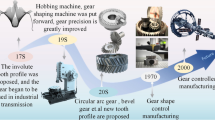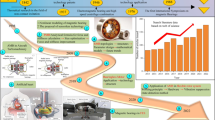Abstract
Gear teeth are subject to two different types of stresses: root bending stress and tooth contact stress. Gear teeth break under these two stresses.: contact stress cause pitting failure at the contact surface, and root bending stress causes fatigue fracture. Thus, while constructing gears, both of these strains must be taken into account. Typically, strongly loaded gears are built of ferrous materials, which can withstand bending loads indefinitely. However, it is impossible to create gears that are impervious to surface failure. In industries where power transmission under big loads with smoother and quieter operation is required, helical gears are frequently utilized. Solidworks, a robust and contemporary solid modelling software, creates three-dimensional solid models with differing face widths to determine stress distribution, and ANSYS, an application for finite element analysis, does the numerical solution. The Lewis stress formula is the foundation of the analytical research. A helical gear was modelled on CAD Software for this paper's stress study, which was completed on ANSYS. The outcomes are then contrasted with AGMA Standard.





















Similar content being viewed by others
Data Availability Statement
My manuscript has no associated data.
References
Achari AS, Chaitanya RP, Prabhu S (2014) A comparison of bending Stress and contact stress of a helical gear as calculated by AGMA standards and FEA. Int J Emerg Technol Adv Engineering 4(5):38–43
Biswas B, Sidar P (2019) Parametric stress analysis of helical gear using FEA. Int Res J Eng Technol 6(9):1030–1034
Bozca M (2018) Helix angle effect on the helical gear load carrying capacity. World J Eng Technol 6(04):825
Bucur M, Cananau S, Mirica RF, & Gabroveanu S (2022, October). Comparative analysis concerning the state of stress for involute gears using ISO, AGMA standards and Finite Element Method. In IOP Conference Series: Materials Science and Engineering (Vol. 1262, No. 1, p. 012002). IOP Publishing.
Budynas RG, Nisbett JK (2011) Shigley’s mechanical engineering design 9. McGraw-hill, New York
Chen K, Ma H, Che L, Li Z, Wen B (2019) Comparison of meshing characteristics of helical gears with spalling fault using analytical and finite-element methods. Mech Syst Signal Process 121:279–298
Chen Z, Zeng M, Fuentes-Aznar A (2020a) Computerized design, simulation of meshing and stress analysis of pure rolling cylindrical helical gear drives with variable helix angle. Mech Mach Theory 153:103962
Chen Z, Zeng M, Fuentes-Aznar A (2020b) Geometric design, meshing simulation, and stress analysis of pure rolling rack and pinion mechanisms. J Mech Des 142(3):031122
Feng W, Feng Z, Mao L (2020) Failure analysis of a secondary driving helical gear in transmission of electric vehicle. Eng Fail Anal 117:104934
He Z, Zhang T, Lin T (2020) Novel mathematical modelling method for meshing impact of helical gear. Mech Mach Theory 152:103949
Huangfu Y, Chen K, Ma H, Che L, Li Z, Wen B (2019) Deformation and meshing stiffness analysis of cracked helical gear pairs. Eng Fail Anal 95:30–46
Jeeva D, Vijayakumar V, Basha JK, Dinesh R, Mohanraj R (2021) Analysis On Bending Stress Of Helical Gear. NVEO-Nat Volat Essential Oils J NVEO 7:3384–3393
Liu Y, Zhao Y, Liu M, & Sun X (2019). A general parameterized high precision finite element modelling method of three-dimensional helical gear. In IOP conference series: materials science and engineering 569(3), 032041). IOP Publishing.
Mohanraj R, Elangovan S, Prakash RA, Sanjeev S, Swetha R, Agalya K (2020) Stress analysis on single and herringbone helical gears. Mater Today: Proceed 22:2049–2057
Pradhan S, Singh H, & Parkarsha O (2021). Bending Strength Analysis of Involute Helical Gear Using FEA Software. In Advances in Engineering Design (pp. 651–660). Springer, Singapore.
Roda-Casanova V, Gonzalez-Perez I (2021) Investigation of the effect of contact pattern design on the mechanical and thermal behaviors of plastic-steel helical gear drives. Mech Mach Theory 164:104401
Ruchert COFT, Maciel CIS, Chemin AEA (2020) Sub case origin fatigue in teeth of helical gear of a TA 67n turbo reducer. Eng Fail Anal 108:104286
VenkatKumar G, Sarath Chandra CH, Krishna Prasad K, & Chengaiyan P, (2018) Load sharing based analysis of helical gear using finite analysis method, Int J Creat Res Thoughts, 6(1):
Wang C (2021) Multi-objective optimal design of modification for helical gear. Mech Syst Signal Process 157:107762
Wang ZG, Chen YC (2020) Design of a helical gear set with adequate linear tip-relief leading to improved static and dynamic characteristics. Mech Mach Theory 147:103742
Yuan B, Liu G, Yue Y, Liu L, Shen Y (2021) A novel tooth surface modification methodology for wide-faced double-helical gear pairs. Mech Mach Theory 160:104299
Funding
The authors have not disclosed any funding.
Author information
Authors and Affiliations
Corresponding author
Ethics declarations
Conflict of Interest
None to declare.
Additional information
Publisher's Note
Springer Nature remains neutral with regard to jurisdictional claims in published maps and institutional affiliations.
Rights and permissions
Springer Nature or its licensor (e.g. a society or other partner) holds exclusive rights to this article under a publishing agreement with the author(s) or other rightsholder(s); author self-archiving of the accepted manuscript version of this article is solely governed by the terms of such publishing agreement and applicable law.
About this article
Cite this article
D, D., Tamilselvam, P. Theoretical and analytical research on load sharing in helical gear with evaluating the FEA method and computerized approach of AGMA standards. J Comb Optim 45, 87 (2023). https://doi.org/10.1007/s10878-023-01003-y
Accepted:
Published:
DOI: https://doi.org/10.1007/s10878-023-01003-y




